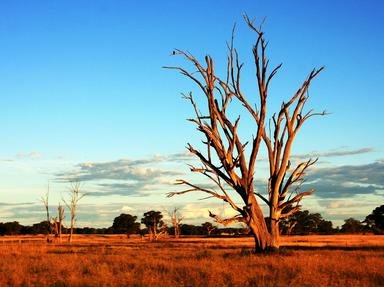Quiz Answer Key and Fun Facts
1. Katherine, in the Northern Territory of Australia, began its life as a small settlement in 1872. What was discovered there in 1889 that helped the town develop further?
2. Right in the middle of nowhere in the Northern Territory of Australia is a small town known as Tennant Creek. It is known for its nearby rounded rock formations. What is their diabolical name?
3. Found in the remote south west area of South Australia is one place you wouldn't want to call home. Now known as Oak Valley, which shameful deed was carried out there in the 1950s by an overseas nation?
4. Marree is located in the north of South Australia. It makes the previous town look over-populated. Astonishingly so, this desolate spot was home to a specific building that was the first of its kind in Australia. What was it?
5. Just so you don't become too thirsty taking this dry quiz, we'll now travel down to the more fertile state of Victoria. The town of Horsham there is a lot larger and greener, and is built on the Wimmera River. The original settlers weren't terribly imaginative though. That river has two main tributaries. One is Burnt Creek. What is the other?
6. Wodonga, Victoria, is right on the border with the New South Wales city of Albury. Located a couple of hundred miles away from Melbourne, this city lies on the country's most important river, the Murray. In relation to this river, what first constructed object claims its right to be included in the pages of history?
7. This small area is located almost in the dead centre of Tasmania. One of the coldest non-alpine places in Australia, its aboriginal name is Miena. Based on the pictured clue, what does that name translate to in English?
8. Located 500 miles to the north-west of Sydney, the New South Wales town of Bourke began its life as a result of resistance from the local indigenous people when Europeans first settled there. Most other inland places began with the establishment of a farm or a cattle station. What was Burke's belly button?
9. Barcaldine is a town located smack bang in the central west of Queensland. It is famous for being the birthplace of one of Australia's major political parties, an organisations given birth by the workers of which occupation?
10. Cloncurry is a town in the north-west of Queensland, almost 500 miles away from the next major town. What was discovered there in 1867 which saw the birth of this inland town?
Source: Author
Creedy
This quiz was reviewed by FunTrivia editor
Tizzabelle before going online.
Any errors found in FunTrivia content are routinely corrected through our feedback system.

